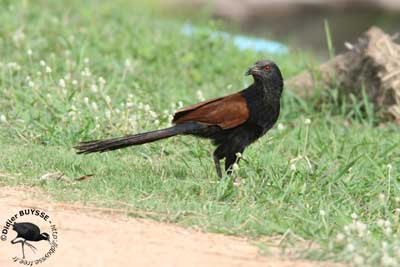
Greater Coucal
Centropus sinensis
Cuculiforme Order – Cuculidae Family
BIOMETRICS:
Length: 47-53 cm
Weight: 236-268 g
DESCRIPTION:
Greater Coucal is a beautiful terrestrial bird, and although it resembles pheasants, it belongs to Cuculidae family, but it is not a brood parasite. It is also known as Crow Pheasant or Coucal.
PROTECTION / THREATS / STATUS:
Greater Coucal is common and widespread in its range, but some populations are locally threatened by habitat loss.
Fr: Grand coucal
All : Heckenkuckuck
Esp : Cucal Chino
Ital : Cuculo fagiano maggiore
Nd : Chinese Spoorkoekoek
Russe : Шпорцевая кукушка
Photographs by Didier Buysse
His website :
Vision d’Oiseaux
Text by Nicole Bouglouan
Sources :
HANDBOOK OF THE BIRDS OF THE WORLD vol 4 by Josep del Hoyo-Andrew Elliott-Jordi Sargatal - Lynx Edicions - ISBN: 8487334229
LES OISEAUX DE THAILANDE par Roland Eve et Anne-Marie Guigue - Times Editions - ISBN: 9812042008
Wikipedia (Wikipedia, The Free Encyclopedia)

Adult has glossy black-purple head and body. Wings are bright chestnut on upperwing, and black on underwing. Long graduated tail is glossy dark green. Contrast between chestnut and black is very conspicuous in adults.
Strong, heavy bill is blackish. Eyes are deep red. Legs and feet are dark grey.
Both sexes are similar.
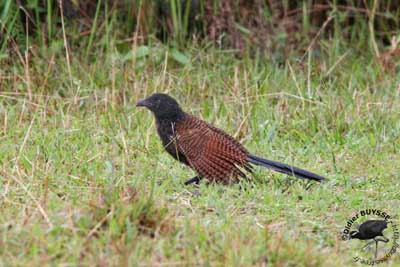
Juvenile has black streaks on chestnut parts and pale buff streaks on black parts.
VOICE: SOUNDS BY XENO-CANTO
Greater Coucal’s song is often uttered in duet with other Coucal. It is a deep “coop-coop-coop-coop-coop”, low-pitched. It gives this sound in particular posture, with buttressed body, and with head and neck convulsed downwards. This attitude favours sound propagation over long distances, with ground used as reflector.
HABITAT:
Greater Coucal lives in grassland and second growth, at forest edges, near cultivated areas and water. It is also found in mangroves, scrubs, marshes, reed beds and gardens.
RANGE:
Greater Coucal is resident in southern Asia, from India east to south China and Indonesia.
BEHAVIOUR:
Greater Coucal feeds a wide variety of preys. It feeds while walking in tall grasses and thickets. It walks slowly like a pheasant, with held horizontal tail, or it skulks through dense undergrowth. This bird hunts on the ground, and may hop and run actively when pursuing prey. Sometimes, it picks up some vegetation and other food items.
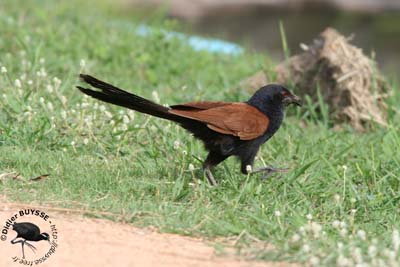
Greater Coucal is a bird rather secretive, often concealed into dense vegetation. Sometimes, in the evening, it perches in a bush top, above the lower vegetation. It readily perches in trees where it can clamber and hop about easily.
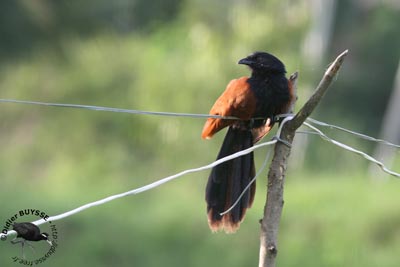
Greater Coucals are monogamous and breed during rains, from February to September, but varying locally. It is resident in its range, and some populations are locally migratory.
Greater Coucal is usually found singly or in pairs, walking along the ground in the undergrowth.
FLIGHT:
Greater Coucal flies at low elevation, with heavy wing beats. Its flight is weak, slow and clumsy. It usually hops from branch to branch to a treetop if it flies long distances. Then, it takes off from the treetop, and flutters and glides downwards, before to disappear into dense cover.

REPRODUCTION:
Greater Coucal’s nest is a large globular mass. It is strongly built, with grasses, leaves and twigs, and tied up to large stems, or hidden in a bush. It may be a deep cup with a dome. Nest materials are loosely woven, and close leaves and stems are bent and woven directly to the structure, without cutting. So, nest remains always green, and perfectly concealed among vegetation. We can see a lateral entrance.
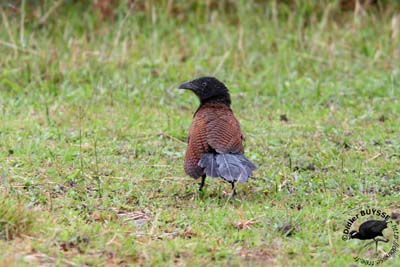
Female lays 3 to 6 whitish glossless eggs. Both parents share all domestic duties.
DIET:
Greater Coucal feeds on large insects, caterpillars, small vertebrates (young mice), snails, lizards, birds’ eggs, fruits and seeds.
